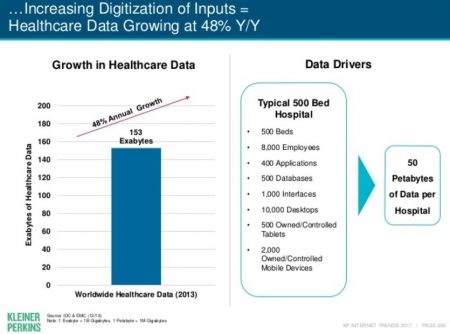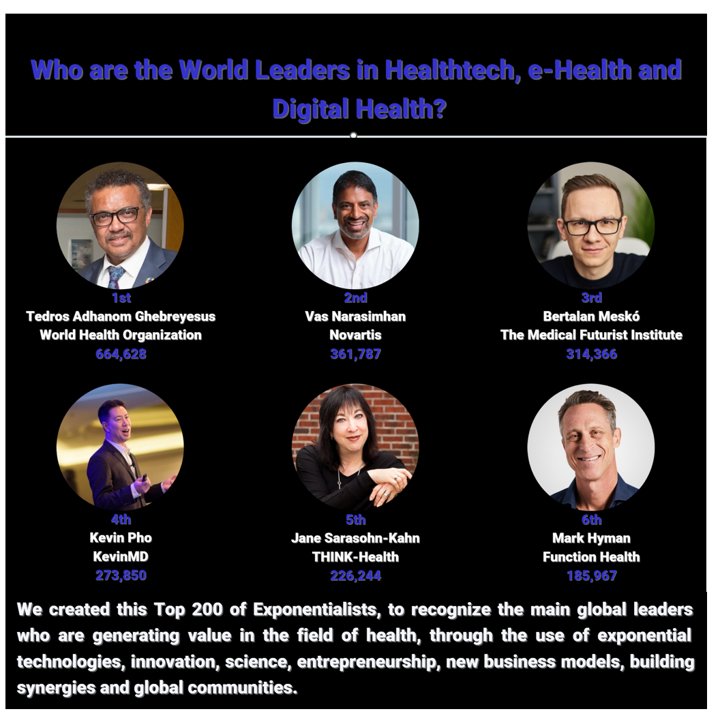 Healthcare is at a digital inflection point, asserts Internet Trends 2017 – Code Conference, by the iconic Mary Meeker of Kleiner Perkins.
Healthcare is at a digital inflection point, asserts Internet Trends 2017 – Code Conference, by the iconic Mary Meeker of Kleiner Perkins.
Published May 31, 2017, few tech-focused reports have the gravitas or generate the readership that this report does. I’m one of Meeker’s perennial readers, covering this report through my health/care lens here on Health Populi for several years (links to previous posts below).
Of the report’s 355 pages, 22 are devoted to healthcare (pages 288-319), a section curated by Noah Kaufman of KP. This section of the report assembles data from a range of publicly available sources, supporting the “inflection point” observation.
This starts with is “today” with the proliferation of technology enabled/digital health devices and data creation. 100 years ago, healthcare was all about the human touch; 25 years ago, machine assisted care in an analog world.
 Four trends represent the digitization of healthcare and a so-called “virtuous cycle of innovation:
Four trends represent the digitization of healthcare and a so-called “virtuous cycle of innovation:
- Digital inputs, with rapid growth in the sources of digital health data, from digital X-rays and wearable sensors for ECGs to digital blood pressure devices and remote health monitoring in the home
- Data accumulation, the proliferation of digitally-native data sets
- Data insight, which follows the accumulation then integration of data, and
- Translation, having an impact on therapeutics and healthcare delivery, the report asserts
Together, these trends drive health outcomes and compressed innovation cycle times.

The key technology players best positioned to participate in the digital health market were identified by Rock Health’s 2016 Consumer Survey, included in this report. Rock Health asked consumers, “with which tech company would you share your data?” The group is led by Google, Microsoft, Samsung and Apple, followed by the trio Amazon, Facebook, and IBM.
The plotline continues with the story of proliferation of health-related data, generataed via consumer-facing health apps and healthcare providers electronic health records systems. Data “accumulation” is an apt noun, because the typical 500-bed hospital generates 50 petabytes of data (remember that 1 petabyte = 1 mm gigabytes).
Digital therapeutics and clinical trial trends are then discussed, followed by examples of organizations leveraging data to optimize patient outcomes, leading to several exhibits on the growth of genomics. The last slide in the genomics story leads with the optimistic, “Digitization = Democratizaton,” with a flow diagram of a DNA sequenced once, queried often by partners in an ecosystem of products, leading to “more empowered and informed consumers.”
Health Populi’s Hot Points: There’s no question that patients, doctors, hospitals, and researchers are creating petabytes of data. That’s volume, the digital data accumulation, that is part of the healthcare Big Data landscape. But just because data is digitized, and there’s a lot of it, doesn’t directly lead to “democratization” of it. Most U.S. Ehalth consumers don’t feel very empowered in 2017, and nor do they feel particularly informed because their healthcare providers don’t readily share “their” (that is, the patients’) personal health information with them.
Digitization of data, spawned by the financial incentives earmarked in the HITECH Act, was part of the economics stimulus package in the ARRA, the American Recovery and Reinvestment Act of 2009 that was signed into law by President Obama. As part of the stimulus effort, liberating health data from paper to electronic formats was seen as part of a strategy to begin to measure, then manage, health care to tame the long-term deficit which was (and largely still is) fed by ever-growing healthcare costs.
But thus far, digitization of healthcare information has been a cost-increasing exercise, not cost-saving, so we’ve got more work ahead of us to get to interoperability of data systems, and analytics that help us measure, manage, and re-imagine health care processes. That democratization is still an elusive, albeit a very desirable, vision.
Here are links to my previous posts on Mary Meeker’s Internet Trends report:
2015 Meeker Internet Trends Report
2014 Meeker Internet Trends Report
2013 Meeker Internet Trends Report
2011 Meeker Internet Trends Report





 I'm in amazing company here with other #digitalhealth innovators, thinkers and doers. Thank you to Cristian Cortez Fernandez and Zallud for this recognition; I'm grateful.
I'm in amazing company here with other #digitalhealth innovators, thinkers and doers. Thank you to Cristian Cortez Fernandez and Zallud for this recognition; I'm grateful. Jane was named as a member of the AHIP 2024 Advisory Board, joining some valued colleagues to prepare for the challenges and opportunities facing health plans, systems, and other industry stakeholders.
Jane was named as a member of the AHIP 2024 Advisory Board, joining some valued colleagues to prepare for the challenges and opportunities facing health plans, systems, and other industry stakeholders.  Join Jane at AHIP's annual meeting in Las Vegas: I'll be speaking, moderating a panel, and providing thought leadership on health consumers and bolstering equity, empowerment, and self-care.
Join Jane at AHIP's annual meeting in Las Vegas: I'll be speaking, moderating a panel, and providing thought leadership on health consumers and bolstering equity, empowerment, and self-care.